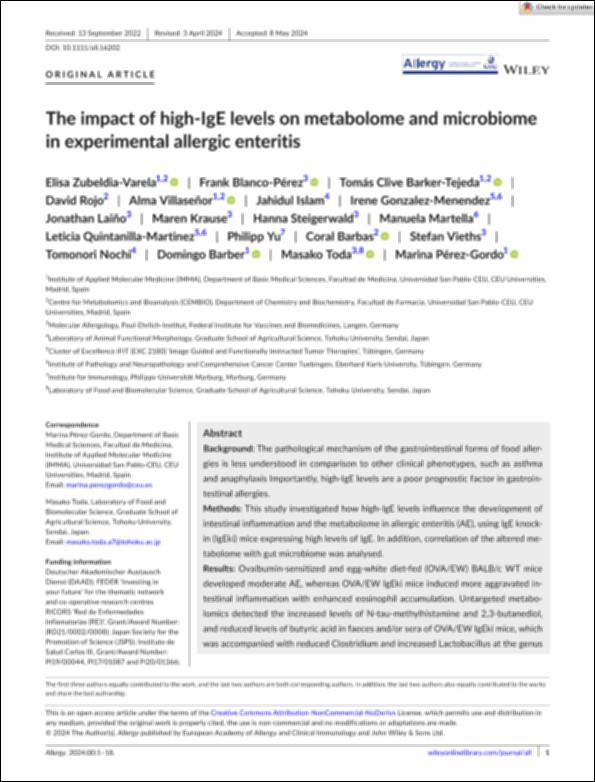Por favor, use este identificador para citar o enlazar este ítem:
http://hdl.handle.net/10637/16084The impact of high-IgE levels on metabolome and microbiomein experimental allergic enteritis
| Título : | The impact of high-IgE levels on metabolome and microbiomein experimental allergic enteritis |
| Autor : | Zubeldia Varela, Elisa Blanco-Pérez, Frank Barker Tejada, Tomás Clive Rojo Blanco, David Villaseñor Solis, Alma Cristina Islam, Jahidul González-Menéndez, Irene Qintanilla-Martínez, Leticia Krause, Maren Steigerwald, Hanna Martella, Manuela Quintanilla-Martinez, Leticia Yu, Philipp Barbas Arribas, Coral. Vieths, Stefan Nochi, Tomonori Barber Hernández, Domingo Toda, Masako Pérez Gordo, Marina |
| Materias: | Microbiome; Food allergy; Metabolomics; Murine model |
| Editorial : | Wiley |
| Citación : | Zubeldia-Varela E, Blanco-Pérez F, Barker-Tejeda TC, et al. The impact of high-IgE levels on metabolome and microbiome in experimental allergic enteritis. Allergy. 2024; 00: 1-18. doi:10.1111/all.16202 |
| Resumen : | Background: The pathological mechanism of the gastrointestinal forms of food aller-gies is less understood in comparison to other clinical phenotypes, such as asthmaand anaphylaxis Importantly, high-IgE levels are a poor prognostic factor in gastroin-testinal allergies.Methods: This study investigated how high-IgE levels influence the development ofintestinal inflammation and the metabolome in allergic enteritis (AE), using IgE knock-in (IgEki) mice expressing high levels of IgE. In addition, correlation of the altered me-tabolome with gut microbiome was analysed.Results: Ovalbumin-sensitized and egg-white diet-fed (OVA/EW) BALB/c WT micedeveloped moderate AE, whereas OVA/EW IgEki mice induced more aggravated in-testinal inflammation with enhanced eosinophil accumulation. Untargeted metabo-lomics detected the increased levels of N-tau-methylhistamine and 2,3-butanediol,and reduced levels of butyric acid in faeces and/or sera of OVA/EW IgEki mice, whichwas accompanied with reduced Clostridium and increased Lactobacillus at the genus level. Non-sensitized and egg-white diet-fed (NC/EW) WT mice did not exhibit anysigns of AE, whereas NC/EW IgEki mice developed marginal degrees of AE. Comparedto NC/EW WT mice, enhanced levels of lysophospholipids, sphinganine and sphin-gosine were detected in serum and faecal samples of NC/EW IgEki mice. In addi-tion, several associations of altered metabolome with gut microbiome—for exampleAkkermansia with lysophosphatidylserine—were detected.Conclusions: Our results suggest that high-IgE levels alter intestinal and systemic levelsof endogenous and microbiota-associated metabolites in experimental AE. This studycontributes to deepening the knowledge of molecular mechanisms for the developmentof AE and provides clues to advance diagnostic and therapeutic strategies of allergicdiseases |
| URI : | http://hdl.handle.net/10637/16084 |
| Derechos: | http://creativecommons.org/licenses/by-nc-nd/4.0/deed.es Open Access |
| ISSN : | 1398-9995 |
| Cubierto por: | Acuerdo Transformativo - 2024 |
| Fecha de publicación : | 23-jun-2024 |
| Centro : | Universidad San Pablo-CEU |
| Aparece en las colecciones: | Medicina |
Los ítems de DSpace están protegidos por copyright, con todos los derechos reservados, a menos que se indique lo contrario.


